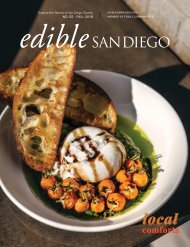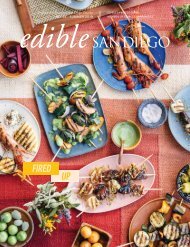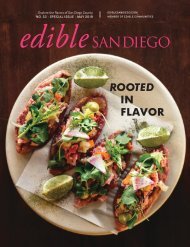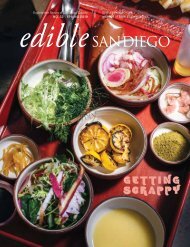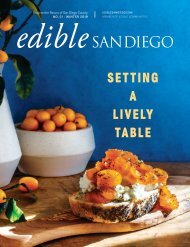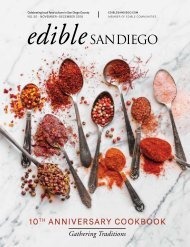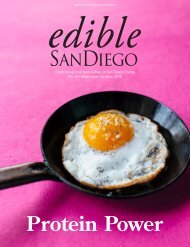Edible San Diego Issue 45 January/February 2018
E-edition of Edible San Diego Issue 45 January/February 2018
E-edition of Edible San Diego Issue 45 January/February 2018
You also want an ePaper? Increase the reach of your titles
YUMPU automatically turns print PDFs into web optimized ePapers that Google loves.
ars for the wild rabbits. My<br />
favorite apricot tree was felled by<br />
a fungus. And marauding coyotes<br />
claimed the chickens in a series of<br />
brazen daylight attacks.<br />
This local food thing,<br />
it isn’t easy<br />
In theory, <strong>San</strong> <strong>Diego</strong> is an<br />
idyllic location for locavores—<br />
people who aspire to eat a diet<br />
consisting only or principally of<br />
locally grown or produced food.<br />
According to the <strong>San</strong> <strong>Diego</strong><br />
County Farm Bureau, our farm<br />
economy ranks 12th in the nation.<br />
The Mediterranean climate<br />
helps support about 5,732 small<br />
farms, 68% of which are smaller<br />
than 10 acres in size. That makes<br />
<strong>San</strong> <strong>Diego</strong> County home to the<br />
highest concentration of small<br />
family-run farms in the U.S. But<br />
then you run into all the ‘buts.’<br />
Principally, that means water.<br />
According to the <strong>San</strong> <strong>Diego</strong><br />
Food System Alliance, <strong>San</strong><br />
<strong>Diego</strong>’s agricultural water rates run<br />
about 30 times higher than those<br />
paid by farmers in the Central<br />
Valley Project or the Imperial<br />
Irrigation District. Land is also<br />
extremely expensive, with housing<br />
constraints pushing values sky high. In<br />
response, the Farm Bureau says that <strong>San</strong><br />
<strong>Diego</strong> growers have increasingly turned<br />
to high-dollar-value-per-acre crops, like<br />
flowers, monocrop strawberries, avocados<br />
(until recently), and lately, marijuana.<br />
So, do we all just give up? Is the dream of a<br />
local food system, of a <strong>San</strong> <strong>Diego</strong> animated<br />
by the spirit of localism, just that—a<br />
dream? Feeling defeated by my own lapsed<br />
intentions, I went looking for inspiration.<br />
The big picture<br />
Jora Vess (Instagram @missjora) is that<br />
modern phenomenon, a social media maven<br />
whose thousands of Instagram followers tune<br />
in for glimpses of the good life. Which often<br />
looks like roasted Da Le Ranch bone marrow<br />
arranged artistically on a plate, next to a pile<br />
of sunflower sprouts grown by a friend.<br />
“I wanted to change the way my family ate. And<br />
when it comes to eating for health, to really trust<br />
the food, it’s all about sourcing.” Jora Vess<br />
“I came to local foods through ancestral<br />
cuisine,” says Jora, who started taking<br />
classes with <strong>San</strong> <strong>Diego</strong> nutritional<br />
educator Annie Dru (lardmouth.com,<br />
@lardmouth) several years ago. “I wanted<br />
to change the way my family ate. And when<br />
it comes to eating for health, to really trust<br />
the food, it’s all about sourcing.”<br />
Local sourcing—procuring products<br />
directly from their grower or maker—takes<br />
Jora to the Hillcrest Farmers’ Market every<br />
weekend. Farmers’ markets (about 50<br />
convene in <strong>San</strong> <strong>Diego</strong> each week) are the<br />
bedrock of food localism. An opportunity<br />
to meet farmers and food makers, to ask<br />
questions, and learn first-hand about<br />
growing conditions, seasonal struggles, and<br />
upcoming harvests.<br />
“I gravitate toward the actual farm<br />
vendors, not the resellers,” says Jora, who<br />
has become friends with most of<br />
the farmers she frequents, getting<br />
to know them while chatting<br />
over Sunday morning produce<br />
purchases. The relationships have<br />
paid dividends. Tom King of<br />
Tom King Farms in Ramona, for<br />
example, gave her an education<br />
in dry farming. And now, when<br />
Jora waxes poetic about his<br />
heirloom melons, black tomatoes<br />
or pomegranates, she can praise<br />
more than just their flavor. She<br />
connects the dots between soil,<br />
growing methods and taste.<br />
That’s one great example of how<br />
localism’s relationships ripple<br />
through the wider community.<br />
Jora isn’t just a high-profile<br />
foodie; within her circle, she’s<br />
become a trusted authority,<br />
helping others better understand<br />
the value of local food beyond<br />
dollars and cents.<br />
But local food is frequently more<br />
expensive than conventional<br />
produce. So a few years back,<br />
Jora also started hosting Pantry<br />
Parties at her Mt. Helix home,<br />
where she has chickens, fruit<br />
trees, and an extensive garden.<br />
“The rule is, you have to bring<br />
something you made or grew,<br />
and enough of it to share,” she<br />
explains. Based on the old world concept<br />
of ‘economies of skill,’ she tells her friends<br />
to “play to their strengths.” So one with<br />
a gift for fermentation brings batches of<br />
homemade kimchee. Another bakes loaves<br />
of sourdough and provides jars of starter.<br />
There are usually eggs, honey, and jam.<br />
Gardeners bring herbs, fruits, and veggies.<br />
It all gets divvied up, an edible form of<br />
redistribution. And the haul, of course, is<br />
documented on Instagram.<br />
What did I learn from Jora? Even a<br />
weekly farmers’ market trip can become<br />
a form of activism. Ask questions. Learn.<br />
Share. And Pantry Parties can help you<br />
and your circle of in-real-life and social<br />
media friends stay motivated.<br />
Continued on page 24<br />
☛<br />
22 edible <strong>San</strong> <strong>Diego</strong> <strong>January</strong>-<strong>February</strong> <strong>2018</strong>









